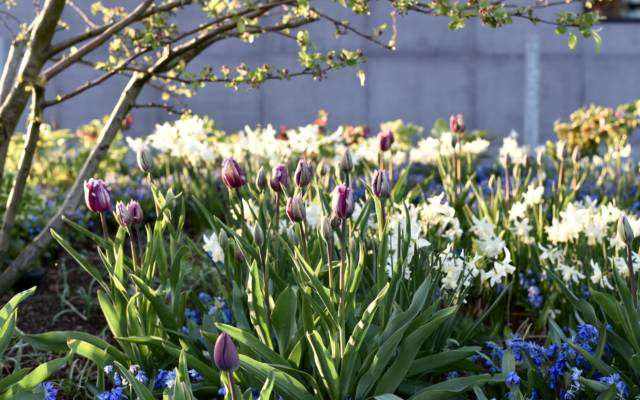
The Hepworth Wakefield Garden
The Hepworth Wakefield Garden is open daily and free to enjoy.
Free entryThe Hepworth Wakefield Garden
The Hepworth Wakefield Garden, designed by internationally acclaimed landscape architect Tom Stuart-Smith, is free for all to enjoy.
Tom Stuart-Smith’s design draws inspiration from its unusual setting between 19th-century red-brick mills and a 21st-century art gallery, edged by the River Calder. It echos the striking, angular shapes of the David Chipperfield-designed gallery while harnessing a naturalism that reflects Barbara Hepworth’s deep connection to the landscape.
As well as Stuart-Smith’s distinctive planting, there are outdoor sculptures by Sir Michael Craig-Martin, Barbara Hepworth and Kim Lim.
Find out about the story of The Hepworth Wakefield Garden here.

Sustainability in our Garden
Whether you’re joining a workshop, spotting butterflies with the iNaturalist app, or simply taking a moment of calm, you’re helping us grow a greener, more resilient Wakefield by visiting our garden.
Find out more about what we are currently working on.
Read MoreSculpture in the garden

Ascending Form (Gloria), 1958
Barbara Hepworth
Wakefield Permanent Art Collection (The Hepworth Wakefield), Donated by Eric and Jean Cass through the Contemporary Art Society 2010
The two diamond shapes in Ascending Form (Gloria) can be seen as representing natural forms, with the one growing organically out of the other, or as a reference to hands coming together in prayer.
One of her most frequently recurring subjects was the standing form, which she related to the feeling of a human figure in the landscape.

Pitchfork (Yellow), 2013
Sir Michael Craig-Martin
Courtesy of the artist and Gagosian
This 4m yellow pitchfork stands tall amongst the trees in the garden. It is taken from a series of giant and brightly coloured painted steel sculptures that resemble commonplace objects.
Appearing like drawings in the air, Craig-Martin’s deceptively simple sculptures pose questions about the role that objects play in our everyday lives.
Hear Michael Craig-Martin describe his sculpture in this short film.

Day, 1966
Kim Lim (1936–1997)
Acquired with the support of the Contemporary Art Society, 1983
This work, Day, which is made from painted steel, was conceived as an outdoor sculpture. The tall arch not only acts as a sun dial casting shadows to gauge the time of day and year, but its elongated form and curved crest echo the elliptical orbit of the earth around the sun.
The acquisition of Day into Wakefield collection in 1983 was prompted by Lim’s close alignment with the sculptural ethos of Barbara Hepworth, as both artists shared a mutual concern for the relationship between abstraction and the landscape.

Fan Construction, 2023
Halima Cassell
Cassell’s distinctive style integrates bold forms with an infinite variety of deeply carved, complex patterns. Combining strong geometric elements with architectural principles, Cassell’s work incorporates recurrent patterns inspired by the geometry and symmetry found in nature, her surroundings and from her own heritage. Born in Pakistan and raised in Lancashire, Cassells varied, multi-cultural background and interest in Islamic art, design and architecture is tangibly present in her work.
Cassell is known for her work in ceramics, and several of her ceramic sculptures are held in Wakefield’s art collection, including Fan 2005, a relief carved in unglazed clay which relates to the patterns reprised in Fan Construction. For this work, Halima has combined pigments to create a warm red hue, which responds to the red brick of Rutland Mills while providing a counterpoint to the concrete of The Hepworth Wakefield.
Dimensions: Cold Cast Iron, 21 foot (h) x 51cm (d)
Our changing display of sculptures in The Hepworth Wakefield Garden has been generously supported by:
In bloom July
Achillea ‘Coronation Gold’
Achillea ‘Coronation Gold’ is commonly known as yarrow. The flat umbels of bright yellow sit above ferny-grey foliage. Achillea love a sunny position and can be found in the middle section of our garden. The plant has a herbal scent and it is popular with pollinators. A beautiful perennial with a long flowering period, which lights up the planting even on grey days.

Allium sphaerocephalon
Allium sphaerocephalon is a summer flowering bulb, which belongs to the onion family. The purple flower-heads sit on tall upright stems, and they can often be found with a bumblebee nestled amongst the magenta flowers foraging for food. They are planted throughout our perennials in scattered groups and their circular pom-poms weave the scene together with their rhymical dots.

Echinacea pallida
Echinacea pallida is a beautiful coneflower that originates from the prairies of North America. The pale pink petals start horizontal and slowly elongate downwards. They enjoy our bright sunny site and self-seed around gently. The stems bristle with tiny hairs and the cone of the flower has robust little pockets of pollen and nectar to reward its pollinators.

Lythrum salicaria ‘Swirl’
This cultivar of purple loosestrife has beautiful upright spikes of bright pink flowers in July. It is a resilient plant and is as happy growing in our dry, free-draining soil, as it would be in a damp and more moisture-retentive spot.

Diary of a Cultural Gardener
Between May 2019 and May 2021, Katy documented her work in a monthly diary to offer a little glimpse into life in The Hepworth Wakefield Garden.
View all of Katy’s diary entries here.
Help Katy care for The Hepworth Wakefield Garden
We have transformed a strip of unused land into a beautiful flower-filled garden, free for all to enjoy. As a living composition, the Garden requires daily care and attention to ensure it remains an urban oasis for everyone.
If you are able, please support this work. Any donation, no matter the size, makes a real difference. Please donate here.











